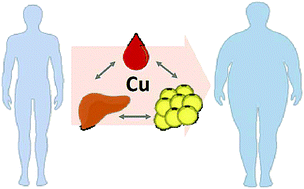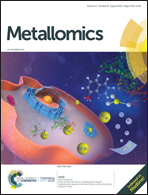Obesity is associated with copper elevation in serum and tissues†
Abstract
Copper misbalance has been linked to fat accumulation in animals and experimental systems; however, information about copper homeostasis in human obesity is limited. In this study, the copper status of obese individuals was evaluated by measuring their levels of copper and cuproproteins in serum, adipose and hepatic tissues. The analysis of serum trace elements showed significant positive and element-specific correlation between copper and BMI after controlling for gender, age, and ethnicity. Serum copper also positively correlated with leptin, insulin, and the leptin/BMI ratio. When compared to lean controls, obese patients had elevated circulating cuproproteins, such as semucarbazide-sensitive amine oxidase (SSAO) and ceruloplasmin, and higher SSAO activity and copper levels in visceral fat. Although hepatic steatosis reduces copper levels in the liver, obese patients with no or mild steatosis have higher copper content in the liver compared to lean controls. In conclusion, obese patients evaluated in this study had altered copper status. Strong positive correlations of copper levels with BMI and leptin suggest that copper and/or cuproproteins may be functionally linked to fat accumulation.



 Please wait while we load your content...
Please wait while we load your content...